Online bullying is an issue for many people who spend time on social media networks and other internet forums. Those who haven’t been a victim of cyberbullying have most likely witnessed it or even participated in it at some point. Members of the LGBTQ community are more likely to be bullied online than their peers. This is a particular concern among LGBTQ youth who may already be facing offline issues, be it at home or at school.
Although online bullying is a major issue, the internet brings about many benefits for LGBTQ youth. They can interact with like-minded individuals who they may not otherwise meet within their local community. Online connections can provide information, advice, and companionship, that might be lacking in their everyday lives. Much of our LGBTQ youth don’t feel supported at home or in school, in which case, the online world may become their place of solace. As such, cutting themselves off from cyberspace as a solution to online bullying is simply not an option.
Instead, LGBTQ youth who are being cyberbullied need help to navigate social media and other platforms comfortably and safely. And parents and educators can help them do this. In this guide, we delve into some of the statistics surrounding cyberbullying and the laws in place to protect would-be victims. We also provide advice for parents and educators to help support LGBTQ children and youth who are being bullied online.
LGBTQ cyberbullying statistics and facts
Cyberbullying is a widespread problem, particularly among younger people. And members of the LGBTQ community are at higher risk than other groups of having to deal with both offline and online bullying. Here are some facts and statistics to help illustrate the issue:
- Over 48 percent of LGBTQ students were cyberbullied via text messages or social media in the past year. 13 percent reported experiencing cyberbullying often. (GLSEN)
- 10 percent of LGBTQ teens have skipped school to avoid being bullied, whereas six percent of heterosexual teens have done the same. This can lead to a lower level of educational attainment among LGBTQ youth. (CDC)
- More than one in five teens who are unsure of their sexual orientation have experienced online bullying. (CDC)
- High school students identifying as lesbian, gay, or bisexual are more than four times as likely to attempt suicide as compared to their heterosexual peers. (CDC)
- LGBTQ youth experience increased online victimization as they age, whereas heterosexual youth don’t. (Computers in Human Behavior)
- LGBTQ youth are at greater risk than other minority groups of having mental health problems as a result of cyberbullying. (Journal of Child & Adolescent Trauma)
- Black LGTBQ youth are at higher risk of mental health issues associated with cyberbullying (as well as other types of bullying) as compared to non-black LGBTQ youth. (American University)
- 56 percent of black LGBTQ youth are considered at risk for depression and 38 percent experienced suicidal thoughts within the past year. (American University)
- 62 percent of transmasculine and 49 percent of transfeminine adolescents have depressive disorders. (AAP)
- The most common mental health issues among transgender children are anxiety disorders and attention-deficit-disorders. (AAP)
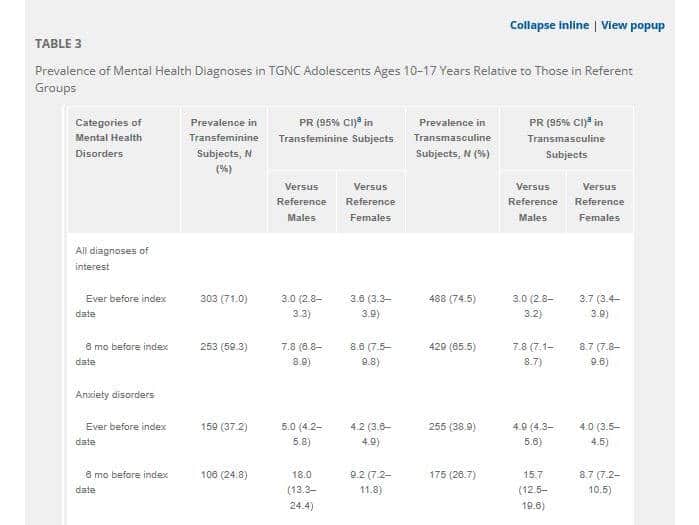
Related: Cyberbullying facts and statistics for 2020
Forms of LGBTQ cyberbullying
Much like offline bullying, cyberbullying can appear in various forms. Even seemingly mild taunts can have a severe psychological impact on any youth. And as reinforced by some of the statistics above, LGBTQ youth are at greater risk of being cyberbullied and are more likely to suffer mental health issues as a result.
Here are some of the problems they may face online:
- Spreading false information.
- Distribution of sensitive or embarrassing messages, photos, videos, or (as in the tragic case of Tyler Clementi) live streams.
- Revelation of information that is intended to be private, for example, being outed by a peer. This was reportedly the reason 16-year-old Channing Smith committed suicide in 2019.
- Online polls designed to cause distress to the subject.
- Groups or pages designed to torment victims. Platforms like Facebook pledge to prevent hate speech, but their tactics are considered largely ineffective.
- Threats of violence or other unwanted actions.
A Pew Research Center study found that the most common forms of cyberbullying are offensive name-calling and the spreading of false rumors.
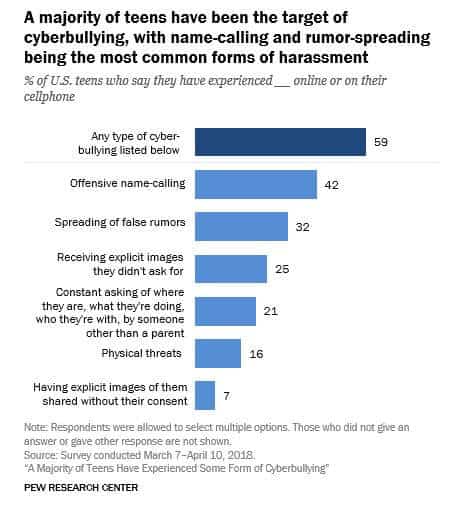
Although a lot of online bullying occurs through text (in messages, comments, and posts), it can also involve other media, such as memes, images, and videos.
Cyberbullying and offline bullying
Online and offline bullying have a lot of similarities, but they have a few differences too. For one, online bullying itself doesn’t involve physical interactions, although it’s not uncommon for online and offline bullying to occur side-by-side and for the latter to become physical.
Another difference between the two is that online bullying can often be more difficult to avoid or escape. Access to smartphones, tablets, and computers means that bullies can “follow” their victims wherever they go, be it at home, school, or even on vacation. Victims would have to avoid the online world completely to escape cyberbullying. Even then, the bullying can still take place behind the scenes unbeknownst to the victim.
This type of relentlessness can really take its toll on victims of cyberbullying. There is literally no safe haven for them to escape to.
Exposure is another big difference. Offline bullying often happens in private or in front of a limited crowd of people. In contrast, online bullying has a much broader potential audience. This can lead victims to overestimate the exposure and conceive that more people are witnessing the bullying than really are.
One more thing to note about online versus offline bullying is the mentality of the bullies. The online world offers a level of anonymity that the offline world doesn’t which can lower the inhibitions of cyberbullies. People who wouldn’t dream of carrying out offline bullying can gain a sense of bravado when sitting at their computer.
Laws surrounding cyberbullying
In some countries, there are specific laws that explicitly cover cyberbullying. But even in countries where these are lacking, many acts of online bullying can be prosecuted under existing laws. For example, LGBTQ cyberbullying might involve:
- Violent threats
- Child pornography (depending on the jurisdiction, any sharing of pornographic images or videos involving a child, even if distributed by the child themselves, could result in a child pornography charge)
- Sending sexually explicit photos or messages
- Recording a video or taking a photo of a person in a place where privacy would be expected
- Stalking
- Harassment
- Hate crimes
With that in mind, here is some information about existing laws in various countries that may be used to prosecute cyberbullying:
US
Most US states do have laws and policies that cover cyberbullying specifically. However, these vary greatly in terms of scope and penalty. You can find out about the bullying and cyberbullying laws for each state on the StopBullying.gov website.
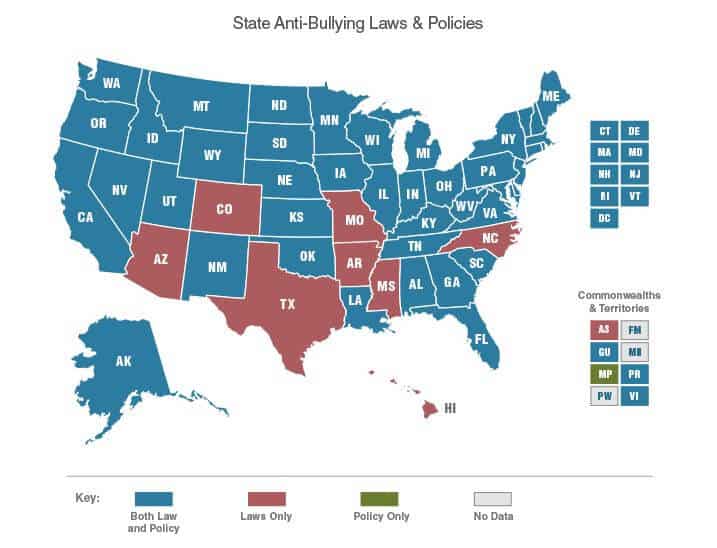
UK
In the UK, there are no specific laws covering cyberbullying. However, there are laws that cover some criminal acts that may be involved in cyberbullying. These include the Communications Act 2003, the Computer Misuse Act 1990, the Protection from Harassment Act 1997, the Malicious Communications Act 1988, the Public Order Act 1986, and the Obscene Publications Act 1959.
Canada
It’s a similar situation in Canada in that no laws explicitly discuss cyberbullying. However, the government of Canada website does list related crimes that may be punishable. These include harassment, threats, intimidation, identity fraud, extortion, counseling suicide, and incitement of hatred.
Australia
Australia’s laws offer a bit more clarity. The Criminal Code Act 1995 (Cth) makes it an offense to use social media, the internet, or a phone to harass, menace, or cause offense. If convicted, the perpetrator can face up to three years in jail or a fine of more than $30,000 AUD. Australian stalking laws can also be applied to online bullying and carry hefty maximum penalties.
In addition to country laws, many schools have policies in place that address cyberbullying. For example, in many US states, schools must include cyberbullying in their respective anti-bullying policies.
Online platform policies against LGBTQ cyberbullying
There’s no denying that much of cyberbullying takes place on social media and messaging platforms. Although, pretty much any platform that allows for open conversation, for example, online games, forums like reddit and Quora, and even dedicated LGBTQ forums themselves could open the door to bullying in some shape or form.
So what protections do LGBTQ youth have against cyberbullying when using these platforms? The good news is that most platforms prohibit cyberbullying (using some wording or other) in their terms of use. Plus, lots of sites have methods in place to report bullying behavior, as well as options for blocking messages and comments from specific users.
The downside is that many of these platforms don’t have a great reputation for backing these policies. While service providers appear to have the best intentions, users often complain that it is difficult to report bad behavior and that nothing is done when they do.
In addition, some of the platforms themselves have been accused of discriminatory behavior. For instance, reports suggest that Instagram actively censors some queer content through “shadow bans.” These bans don’t remove images but instead strategically hide them from users. The recently popularized video creation and sharing platform, TikTok, has also been accused of censoring LGBTQ content.
With that in mind, here are some related excerpts from the policies of several popular platforms:
In Facebook’s Community Standards, a section regarding bullying and harassment includes guidelines about the types of content that are not tolerated. One relevant statement read:
Do not target private adults (who must self-report) or any private minors or involuntary minor public figures with claims about romantic involvement, sexual orientation or gender identity.
Twitter covers cyberbullying under its Hateful conduct policy. This states:
You may not promote violence against or directly attack or threaten other people on the basis of race, ethnicity, national origin, caste, sexual orientation, gender, gender identity, religious affiliation, age, disability, or serious disease. We also do not allow accounts whose primary purpose is inciting harm towards others on the basis of these categories.
It explains that it aims to curb abuse that is motivated by hatred, intolerance, or prejudice such as abuse that targets underrepresented communities. It specifically calls out the LGBTQ community in its rationale.
Instagram’s Community Guidelines page includes a section titled “Respect other members of the Instagram community.” This outlines the types of content Twitter will remove, including threats, hate speech, and content that intends to shame, degrade, blackmail, or harass private individuals (as opposed to public figures for whom the rules aren’t as strict). It also emphasizes that:
It’s never OK to encourage violence or attack anyone based on their race, ethnicity, national origin, sex, gender, gender identity, sexual orientation, religious affiliation, disabilities, or diseases.
How parents can support LGBTQ youth who are cyberbullied
LGBTQ youth may be less likely to inform their parents about online bullying. However, if you do suspect or find out that your child is being bullied online, here are some things you can do to help them.
Here’s what to do if your LGBTQ child is being cyberbullied:
- Offer support and talk to your child
- Think twice before restricting internet use
- Discuss ways they can navigate the online world safely
- Introduce them to support networks
- Help to educate others
Let’s look at these in more detail:
1. Offer support and talk to your child
It may seem obvious, but the best way you can support your child is by offering personal support and talking them through the problems they are facing. One of the main things to address is making sure they realize that cyberbullying is not their fault.
Many children will refrain from discussing their online issues with family members, especially if they haven’t yet come out or if there is a strain on the relationship, for example, due to conflicting beliefs. If they don’t feel comfortable coming to you, suggest other people they may want to talk to such as a friend, family member, teacher, or coach.
2. Think twice before restricting internet use
If you find out your child is being bullied online, a knee-jerk reaction might be to restrict or even ban access to the internet. It seems logical that less exposure to social media platforms and online forums will help to shelter your child from the bullying.
While this makes sense, it’s not always the best course of action. The online world can offer many positive experiences for all children and teens, and especially for LGBTQ youth. Some might find that they can be themselves online in a way that can’t in the offline world. Many strike up friendships with like-minded people across the globe who they might never have been exposed to otherwise. Individuals and groups can offer support and camaraderie, helping LGBTQ youth navigate some difficult waters.
In addition, missing out on what friends are experiencing online could push your child further into the periphery and make them a bigger target for bullying. Plus, the cyberbullying might not stop just because they are absent. Users could still post content that could indirectly affect your child.
Instead of restricting use, it’s often better to help them use various online platforms in such a way that they can still access the support they need, but can also protect themselves from bullying. That said, it’s important that they know it’s okay to take a break from connected devices and to limit time on certain applications.
3. Discuss ways they can navigate the online world safely
Because of the internet, these days children are exposed to a lot more of the world than they would have been in previous decades. The thing is that children and youth themselves haven’t inherently changed. While they are given a lot of autonomy when it comes to social media and other online platforms, it doesn’t mean they are ready for this responsibility.
As mentioned, restricting use may not be the right way to help your child. Instead, here are some ways you can help them stay safe online:
- Help them use online services anonymously: One of the safest ways to have an online presence is to use platforms and forums anonymously. Note that this is primarily intended to help from a safety standpoint and shouldn’t be construed as advice for your child to hide their sexual orientation or gender identity.
- Adjust privacy settings: Along the same lines, it’s hugely important to adjust privacy settings on all platforms. These enable you to control who sees your public posts and prevent certain people from messaging you. You may be able to block some users entirely.
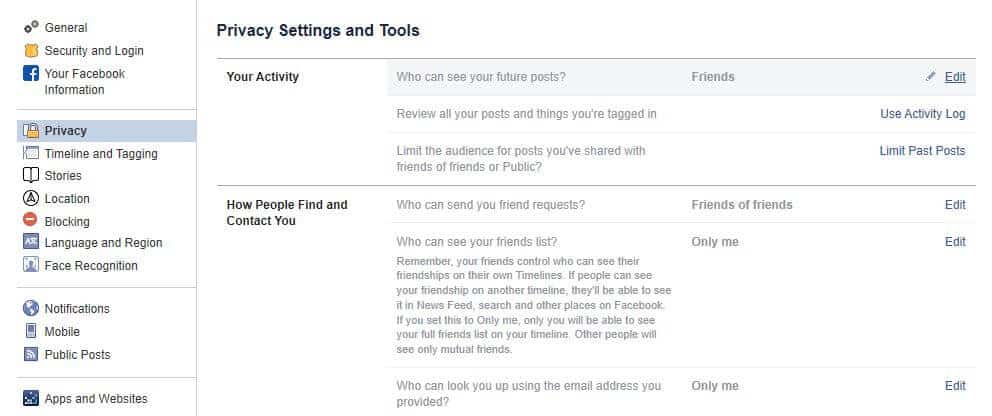
- Discuss the permanency of online content: Although comments, images, and videos can be deleted, for as long as they are available to the public, they can be saved by other people. Bullies can then distribute this content however they choose, even if your child wishes it to remain private.
- Reinforce the idea of stranger danger: We’re used to talking to young children about strangers, for example, people they might meet in the street, but older children and teens need similar lessons about strangers online. People are not always who they purport to be and there are many shady online characters ready to prey on vulnerable youth for various nefarious purposes.
4. Introduce them to support networks
One of the most important things to instill in LGBTQ youth is that they are not alone. They shouldn’t be made to feel like outsiders, but unfortunately, this is often the case. In these situations, it’s helpful to be reminded that there is a whole world of like-minded people out there and that support is available.
Here are some of the resources you can steer your child toward for help with dealing with cyberbullying:
- Dedicated organizations: There are a ton of organizations designed to help LGBTQ youth in various facets of their lives. Here are some of those:
- Forums and social media groups: There are also many social media groups and accounts and online forums set up to help support the LGBTQ community. Examples include the LGBT@Facebook page and the LGBT subreddit thread. Be sure to check the appropriateness of the content for your child’s age and maturity before recommending a forum or group.
- School groups: There may be more support available within your child’s school than you realize. For example, many have LGBTQ alliance groups, provide designated “safe spaces” for LGBTQ students, and can help with access to external resources. Be sure that you and your child are familiar with the support available.
- Local groups: There may be other resources and support groups within your local community. This guide that lists LGBTQ resources by state is a good place to start.
- Counseling services: If your child needs help from a professional in dealing with cyberbullying or other issues, there are always counseling services available. Your family doctor should be able to refer you to someone who can help. Alternatively, in the US, SAMHSA’s National Helpline (1-800-662-4357), also known as the Treatment Referral Routing Service can help with a referral to a counselor. In addition, most countries have helplines specifically for kids, such as Teen Line in the US and Kids Help Phone in Canada. If you are concerned that your child is feeling helpless or hopeless or contemplating suicide, there are hotlines you or your child can call for help:
- US: National Suicide Prevention Lifeline (1-800-273-8255)
- Canada: Crisis Services Canada (1-833-456-4566)
- UK: Hopeline UK (0800 068 41 41)
- Australia: Lifeline (13 11 14)
Of course, you also need to ensure your child knows there is support from local law enforcement if they are the victim of a crime. We discuss reporting cyberbullying and related cybercrimes below.
5. Help to educate others
Children model the behavior of those around them, in particular their parents, so it is up to society at large to change attitudes towards the LGBTQ community. If you feel comfortable doing so, an incredible way to support your child is to help change the way in which the LGBTQ community is treated.
We mentioned some dedicated organizations above, but there are also some groups designed specifically for parents and families of LGBTQ youth. For example, PFLAG National originated in the US but has given way to similar organizations across the globe.
How educators can help the fight against LGBTQ cyberbullying
The CDC School Health Profiles 2018 report (PDF) details how many schools are supporting LGBTQ youth in various ways. Some of the key points considered are:
- Identifying a safe space, for example, a counselor’s office or student organization where LGBTQ youth can expect support from designated school staff.
- Policies in place that prohibit harassment that is based on a students’ actual or perceived gender identity or sexual orientation.
- Encouraging programs whereby staff participates in professional development programs to learn about creating a supportive and safe environment for all students.
- Helping to facilitate access to health service providers off school property, including HIV/STD testing and counseling, and social and psychological services.
- Having a gay/straight alliance club or other groups with similar goals.
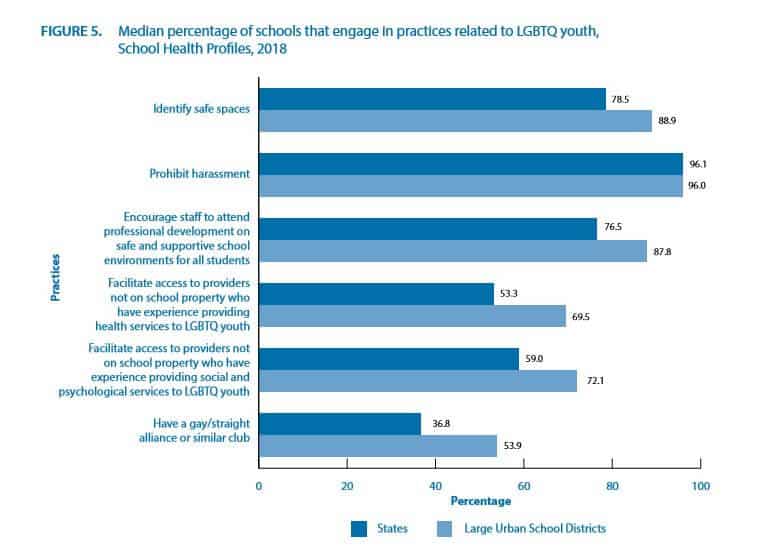
The GLSEN report offered much of the same key advice as the CDC report above. Additional recommendations include:
- Ensuring that policies and practices do not discriminate against members of the LGBTQ community. For example, this could apply to dress codes or school dances.
- Ensuring that gender nonconforming and transgender students have equal access to school activities and facilities.
While this general advice can be helpful, it can be difficult to interpret on a more practical level. Here are some more specific ways in which educators can provide support to LGBTQ youth:
- Pursue training related to issues facing the LGBTQ community, including tackling violence and suicide prevention. Similar age-appropriate training may be offered to groups of students.
- When creating policies, such as those related to bullying, harassment, and discrimination, look to your state’s ED for suggestions.
- Use surveys, interviews, or meetings to find out the attitudes of students and staff towards the LGBTQ community.
- Collaborate with other staff members to come up with strategies to create a safe and inclusive environment for LGBTQ students.
- Create effective “safe zones” by ensuring staff receives the relevant training, safe zones are clearly marked, and students know what their purpose is.
- Create forums that provide a space for discussion on LGBTQ topics.
- Ensure that LGBTQ youth feel represented and included in all facets of school life, for example, by ensuring library materials cover LGBTQ topics.
In general, LGBTQ dialogue should be integrated into everyday school life. Things like including LGBTQ topics in the curriculum, announcing LGBTQ news in assemblies and the school paper, and displaying posters related to LGBTQ events can help to foster a culture of inclusivity.
How to report LGBTQ cyberbullying
One key piece of advice for anyone who is being bullied online is to make a record of all the instances of bullying that take place. The simplest way to do this is to take screenshots of the offending material. This way, if you do go to report the activity, even if the material is no longer available online, it can still be presented. This means the case is not based on hearsay and is backed by evidence.
So who do you need to keep this information for? Well, there are three main routes you can take, depending on the nature and severity of the cyberbullying:
- Report to the online platform on which the cyberbullying is occurring
- Discuss the issue with school staff
- Report the incident(s) to the police or other applicable organization
Let’s look at each of these methods and when they’re appropriate:
1. Reporting on online platforms
As mentioned, most social media platforms have some rules that address online bullying to some extent. Many enable you to report specific content or other users. Here are some relevant pages that explain how to report abuse on popular platforms:
That said, there is much backlash against these platforms as there is often very little evidence of action against perpetrators.
2. Reporting to your child’s school
In many cases, online bullying and offline bullying are linked, and if the bullies attend school with the victim, then the school should be notified of what is happening. Depending on the situation, points of contact may be a teacher, a school counselor, or the school principal.
The response will depend heavily on school policies and the individual school’s attitudes towards bullying and towards the LGBTQ community. If the school is not adequately addressing harassment, you may wish to take the issue higher up. Options include:
- The school superintendent
- The State Department of Education (ED)
- The US ED, Office for Civil Rights
- The U.S. Department of Justice, Civil Rights Division
3. Reporting to local law enforcement or other applicable organization
Some forms of cyberbullying are considered criminal offenses, in which case they should be reported to local law enforcement. Exact laws vary depending on what country or state you’re located in, but we discussed above some of the acts which typically constitute criminal activity.
However, even if you believe a crime has been committed, it can be difficult to know who to turn to. As always, if there is an emergency situation, you should dial 911 (or your country’s equivalent). If you believe a crime has been committed, but there is no emergency, you should contact your local police. Here are a few other organizations you can report to, depending on your location and the nature of the cyberbullying:
US
UK
- Child Exploitation & Online Protection Centre (to report grooming or sexual abuse)
- Report Harmful Content (this site explains how to report specific types of content)
Australia
- ReportCyber (reporting for those over 18)
- eSafety (reporting for those under 18)

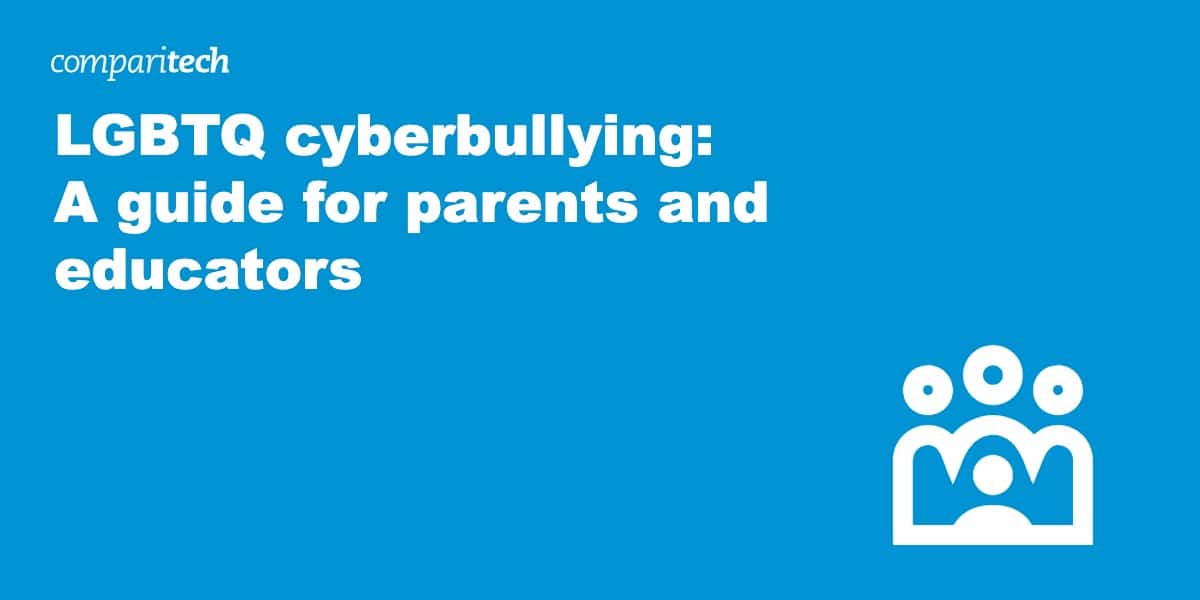
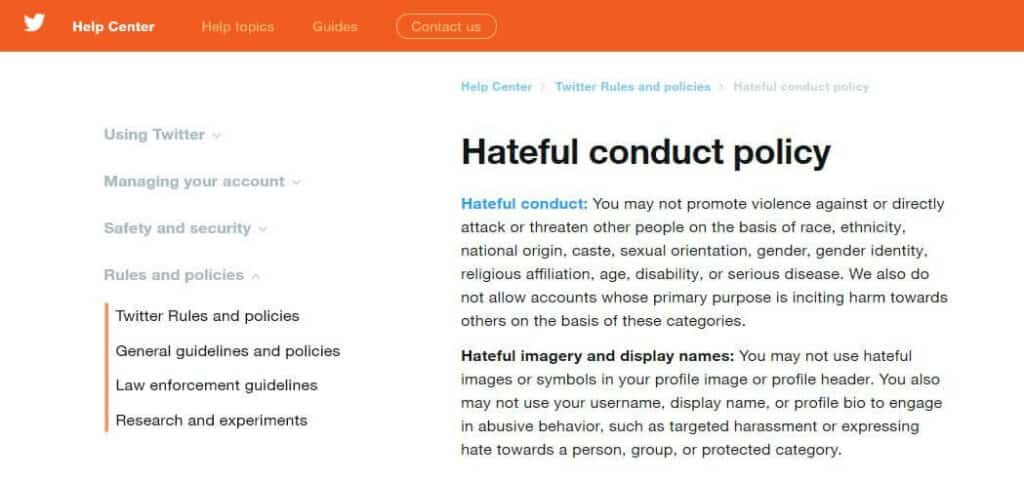
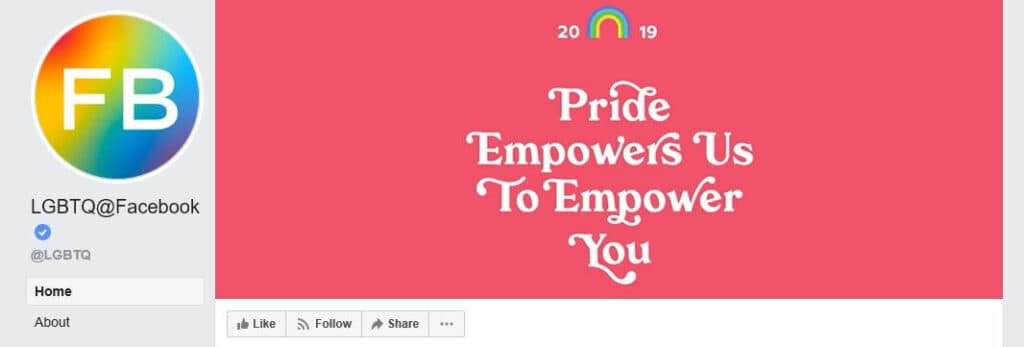
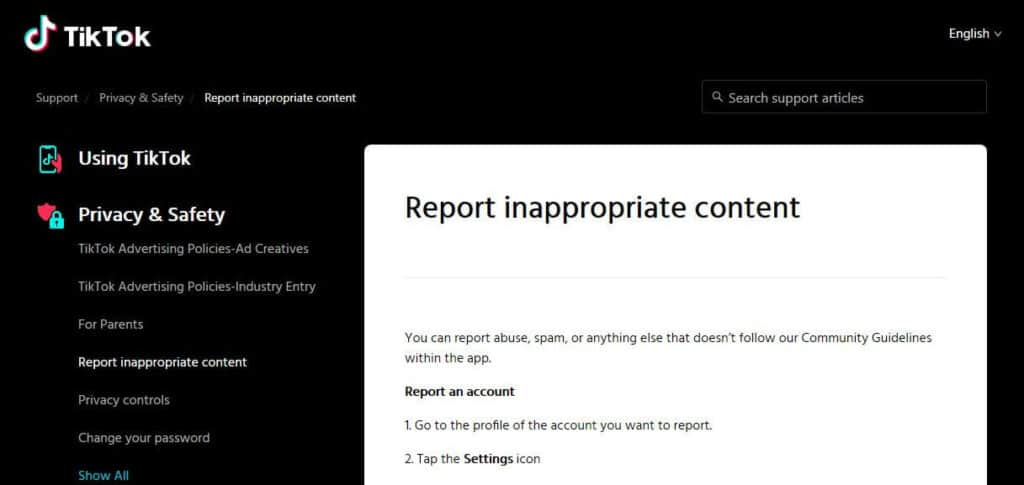

I am glad to know that our children can be helped and supported in a safe and useful way while they navigate the internet.This brings much relief.
It is sad that cyber bullying takes place period, but this article gave some very thoughtful and meaningful ways to help children navigate the problem.